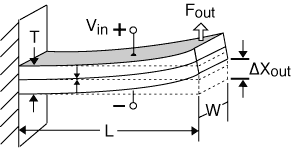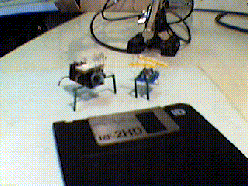 other expands, causing the
element to bend.
other expands, causing the
element to bend.Bilayers of piezoelectric materials are used also as motors and actuators, usually containing many layers of adhesive, electrodes, and a central shim layer. Each of these two layer constructions can be used in two ways - bending and extending. The extension only uses one direction of motion whereas the bending motion can take different forms depending on how the piezoelectric film is anchored.
Increasing the number of layers of piezoelectric material in the stack increases the volume fraction of the piezoelectric material. At a higher volume the energy that can be extracted from a particular load increases, but the practicality of wiring electrodes to each layer means that a maximum of 4 layers is actually possible.
Another interesting use for these
materials is as legs for microrobots. If a bilayer of two piezoelectric materials
is used, the legs can be made to bend as far as needed for the robot to "walk".
This is induced by putting a common electrode between the two layers which are
arranged so that for the same voltage applied one will contract when the
 other expands, causing the
element to bend.
other expands, causing the
element to bend.
For a fully mobile robot, the legs need to be capable of moving vertically and horizontally, and this is achieved by the incorporation of both a "femur" and "tibia" in each leg.
This picture found at Piezo Systems, Inc.
(without permission)

Image found at Piezo Light Intelligent Flea
(without permission)